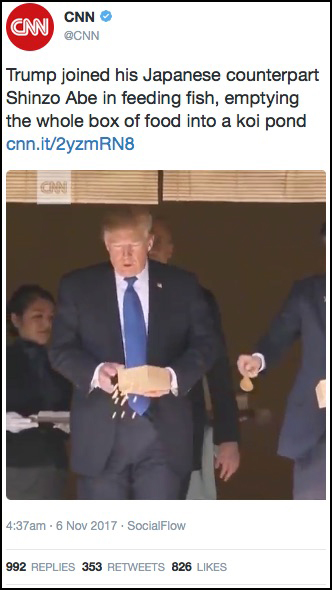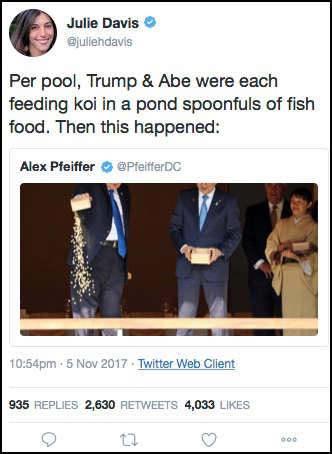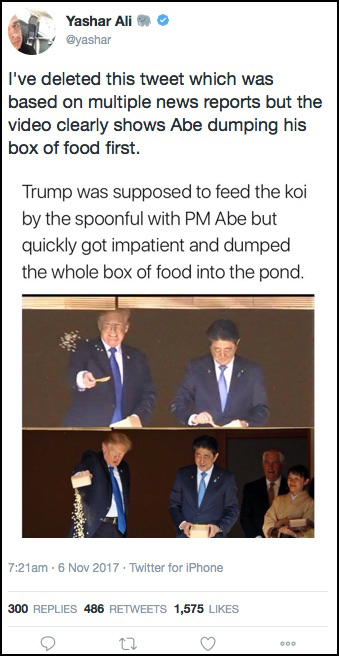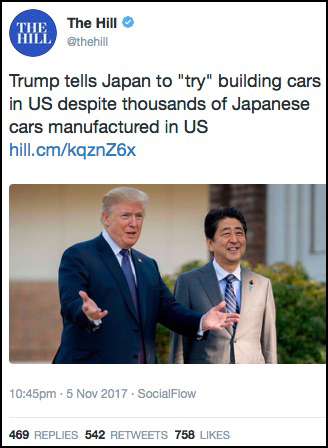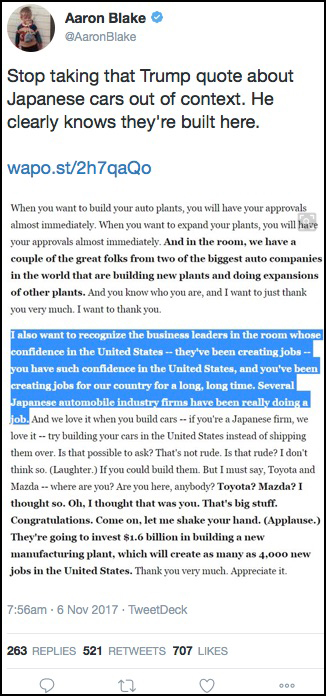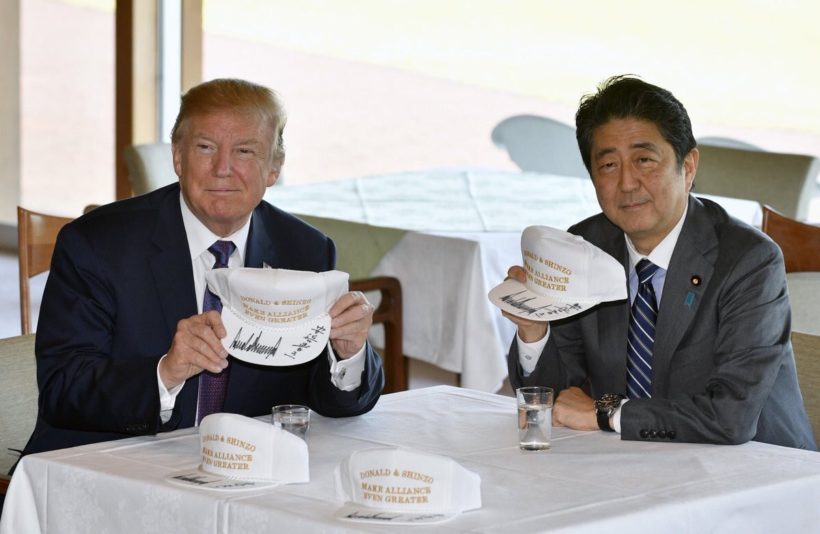
When President Trump arrived on Sunday at the Kasumigaseki Country Club outside Tokyo to play golf with Prime Minister Shinzo Abe, the Japanese leader surprised Trump with a hat featuring a play on Trump’s “Make America Great Again” slogan which read, “Donald & Shinzo, Make Alliance Even Greater.”
redo Jump to...
print Print...
Example of Media Bias:
…CNN circulated a deceptively edited video on Sunday that appeared to show President Trump, who was feeding koi fish with his Japanese counterpart Shinzo Abe, simply dumping his box of fish food into the pond.
The apparent breach of fish-feeding protocol immediately went viral, as Trump was seen as too impatient to thoughtfully spoon the fish food into the pond, as Abe was doing.
Here’s how CNN edited the video:
.
Here is one of the many tweets CNN published:
CNN also wrote up a news story about the fake fish story:
The Huffington Post’s Yashar Ali was one of many journalists to circulate the false report, snidely tweeting that “Trump was supposed to feed the koi by the spoonful with PM Abe but quickly got impatient and dumped the whole box of food into the pond.”
The New York Times’s Julie Davis likewise helped spread the myth:
The only problem is that … it’s all untrue.
As the non-edited video below shows, both leaders casually spooned fish food to the koi; after doing so for approximately 30 seconds, Abe dumped the remainder of his box into the pond; Trump, following Abe’s lead, then does the same:
.
Yashar Ali, to his credit, deleted his tweet:
The other fake scandal concerns Trump apparently suggesting to Abe that Japan should build cars in the United States and create American jobs, rather than import them from Japan.
Haha, journalists sniffed, everyone knows Japan already manufactures cars in America!
Take, for example, this sample treatment from Slate:
The Hill also helped make this fake story go viral:
As did CBS’s White House reporter, Mark Knoller:
Again, the only problem with this story is that it’s untrue.
After spreading uncorrected for almost 24 [hours], The Washington Post’s Aaron Blake tweeted a debunking:
As the full quote makes clear, Trump not only is aware Japan manufactures cars in America, but he specifically thanks them for all of the jobs they’re creating. “I also want to recognize the business leaders in the room whose confidence in the United States — they’ve been creating jobs — you have such confidence in the United States, and you’ve been creating jobs for our country for a long, long time. Several Japanese automobile industry firms have been really doing a job,” Trump says.
He then thanks Toyota and Mazda specifically for a new plant they’re building in the U.S.:
And we love it when you build cars — if you’re a Japanese firm, we love it — try building your cars in the United States instead of shipping them over. Is that possible to ask? That’s not rude. Is that rude? I don’t think so. (Laughter.) If you could build them. But I must say, Toyota and Mazda — where are you? Are you here, anybody? Toyota? Mazda? I thought so. Oh, I thought that was you. That’s big stuff. Congratulations. Come on, let me shake your hand. (Applause.) They’re going to invest $1.6 billion in building a new manufacturing plant, which will create as many as 4,000 new jobs in the United States.
(from Grabien News, Nov. 5)
To accurately identify different types of bias, you should be aware of the issues of the day, and the liberal and conservative perspectives on each issue.
Types of Media Bias:Questions
1. What type of bias is CNN’s edited video an example of?
2. a) How does the edited clip of President Trump and Prime Minister Abe feeding koi fish affect your view of President Trump? (What false impression did CNN’s edited version give you about President Trump?)
b) How does the unedited clip change your view?
3. Why do you think CNN chose to give viewers a false impression of the President?
Scroll down to the bottom of the page for the answers.
Answers
1. Bias by SPIN.
2. a) The edited version gives me the impression that President Trump is a boorish oaf who isn’t aware or doesn’t care about cultural proprieties; that he is a president who embarrasses America.
b) The unedited clip shows me that President Trump is actually a gracious person who has good manners and understands how to act in various cultural situations.
3. Opinion question. Answers vary.
